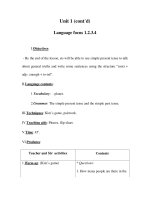4 2 3 hello, good bye, and other customs (expository nonfiction)
Bạn đang xem bản rút gọn của tài liệu. Xem và tải ngay bản đầy đủ của tài liệu tại đây (1.47 MB, 6 trang )
Reader
Hello, Good-bye,
and Other
Genre
Build Background
Expository
Nonfiction
• World Cultures
• Customs
• Communication
Access Content
Customs
Extend Language
• Definitions
• Farewell Words
• Graphic Aids • Homophones
Scott Foresman Reading Street 4.2.3
ì<(sk$m)=bebje < +^-Ä-U-Ä-U
ISBN 0-328-14194-1
by Anthony James
Talk About It
1. Why do you think greeting people is an important
activity all over the world?
2. How do people treat older people in many countries?
Hello, Good-bye,
Write About It
and Other
Customs
3. On a paper, make a Venn diagram to compare and
contrast any two customs of greeting or farewell
in this book or another custom that you know.
Greeting in
Japan
Both
Greeting in
France
Extend Language
Homophones are words that sound alike. The verb
bow (that rhymes with now) sounds just like the
word bough. Bough means “a tree branch.” Bow and
bough are homophones. Find a word in this book
that is a homophone of waste.
Photographs
Every effort has been made to secure permission and provide appropriate credit for photographic material. The
publisher deeply regrets any omission and pledges to correct errors called to its attention in subsequent editions.
Cover ©Frans Lemmens/Getty Images; 1 ©Getty Images; 2 (BL, BR) ©Royalty-Free/
Corbis; 3 (BL, BR) ©Royalty-Free/Corbis; 4 ©Getty Images; 6 ©Richard Hackett/OmniPhoto Communications, Inc.; 7 ©Frans Lemmens/Getty Images; 8 ©Hinata Haga/The
Image Works, Inc.
by Anthony James
ISBN: 0-328-14194-1
Copyright © Pearson Education, Inc.
All Rights Reserved. Printed in the United States of America.
This publication is protected by Copyright, and permission should be obtained from
the publisher prior to any prohibited reproduction, storage in a retrieval system,
or transmission in any form by any means, electronic, mechanical, photocopying,
recording, or likewise. For information regarding permission(s), write to: Permissions
Department, Scott Foresman, 1900 East Lake Avenue, Glenview, Illinois 60025.
Editorial Offices: Glenview, Illinois • Parsippany, New Jersey • New York, New York
1234
5 6 7Offices:
8 9 10 Needham,
V0G1 14 13
12 11 10 09 08
07 06 05
Sales
Massachusetts
• Duluth,
Georgia • Glenview, Illinois
Coppell, Texas • Sacramento, California • Mesa, Arizona
Customs
How do you greet people when you meet
them? How do you wish them well, when they
leave? Do you speak one way to someone your
age, but another way to someone older?
It may surprise you, but people all over the
world have different ways of doing these things.
These different ways are called customs.
Sometimes we are not very aware of customs.
We learn them just by living with our family.
When we are little, we watch what others do,
and we do the same things too.
2
But if we travel to other countries, we notice
customs right away. We may notice that when
people talk they are very polite and keep their
eyes down. In some countries, people may stand
closer to each other than some of us normally do.
Customs are just ways that people do things.
Different customs are not correct or incorrect.
They are just different. And some customs are
very interesting! Read the following examples,
and you will see.
3
Bowing
in Japan
People in the
United States have
many ways of saying
hello and good-bye.
Adults may just say
the words, or they
may shake hands
too. They may even
say hello or goodbye as they hug and kiss.
In Japan, people say the Japanese words for
hello and good-bye, but they also bow. Bowing
properly is very important. People practice until
they are capable of doing it just right.
Men and boys keep their hands at their sides
and bow from the waist. Women and girls place
their hands just touching in front.
bow: to lower one’s head, or sometimes to lower the
entire upper body from the waist
4
In a proper bow,
people have their
backs straight and
their heels together.
They keep their
eyes lowered. When
people rise, they do
it slowly. A bow lasts
about three seconds.
Sometimes one
person rises from
bowing before the
other person does. This can make the person feel
awkward. If this happens, the person who rose
bows again. Often, people bow several times,
especially when saying good-bye. The lower a
person bows, the more respect or emotion they
are showing.
Some bows are done while standing, and
others while kneeling. People also bow to say
“I’m sorry” and “thank you.”
rise: come up
5
Arab Countries
People in Arab countries shake hands when
they say hello and good-bye. After a handshake,
people sometimes place their right hands over
their hearts to show that they are sincere.
When greeting close friends, Arab men use
both hands to shake hands. Men shake hands
only with men. It is not considered polite for men
and women to shake hands.
India and Thailand
Here are some ways people say hello and
good-bye in other countries.
The traditional way of greeting people in
India and Thailand also shows respect. People
bring their hands together close to their chests as
if they were praying and do a slight bow.
France
In France, as in many countries in Europe,
people sometimes kiss each other on both cheeks
when saying hello and good-bye. The right
cheek is kissed first, and then the left. Sometimes
people do not actually kiss the cheeks. They just
“kiss the air” as they press their cheeks together.
Extend Language
sincere: honest, real
Farewell and Good-Bye
People occasionally say farewell as another English
word for good-bye. Farewell means “I wish you
well.” Farewell also is used as an adjective, We went
to his farewell dinner, or as a noun, We gave her a
nice farewell. Good-bye is a short form of a wish that
originally was “God be with you.”
6
7
Talk About It
Respect for
Older People
Respect for
older people is
very important in
many countries.
In the Philippines,
young people
have a special way
of greeting older
people. The young
person takes the
older person’s right
hand and brings
his or her forehead down to touch the older
person’s hand.
1. Why do you think greeting people is an important
activity all over the world?
2. How do people treat older people in many countries?
Write About It
3. On a paper, make a Venn diagram to compare and
contrast any two customs of greeting or farewell
in this book or another custom that you know.
Greeting in
Japan
Both
Greeting in
France
Extend Language
Homophones are words that sound alike. The verb
bow (that rhymes with now) sounds just like the
word bough. Bough means “a tree branch.” Bow and
bough are homophones. Find a word in this book
that is a homophone of waste.
Photographs
Knowing About Customs
Every effort has been made to secure permission and provide appropriate credit for photographic material. The
publisher deeply regrets any omission and pledges to correct errors called to its attention in subsequent editions.
There is no book that can tell all there is to
know about customs. People have customs for
almost everything they do—dressing, eating,
celebrating, and working. There are even
customs for giving and receiving gifts.
But now you know a little about some customs
in a few countries.
Can you think of some customs of the United
States or other countries that you could share?
Cover ©Frans Lemmens/Getty Images; 1 ©Getty Images; 2 (BL, BR) ©Royalty-Free/
Corbis; 3 (BL, BR) ©Royalty-Free/Corbis; 4 ©Getty Images; 6 ©Richard Hackett/OmniPhoto Communications, Inc.; 7 ©Frans Lemmens/Getty Images; 8 ©Hinata Haga/The
Image Works, Inc.
ISBN: 0-328-14194-1
Copyright © Pearson Education, Inc.
All Rights Reserved. Printed in the United States of America.
This publication is protected by Copyright, and permission should be obtained from
the publisher prior to any prohibited reproduction, storage in a retrieval system,
or transmission in any form by any means, electronic, mechanical, photocopying,
recording, or likewise. For information regarding permission(s), write to: Permissions
Department, Scott Foresman, 1900 East Lake Avenue, Glenview, Illinois 60025.
1 2 3 4 5 6 7 8 9 10 V0G1 14 13 12 11 10 09 08 07 06 05
8









